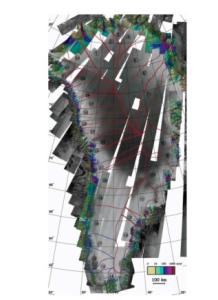Study of Ice Flow using IceSAR 2012 Data and Design of Ice Sheet Observation Mission - Phase 1 (old title: P-band Multiphase Centre SAR and Ice-Sounder)

The objectives of the present study are to: (1) Demonstrate the feasibility of accurate ice flow estimation using the IceSAR 2012 campaign data acquired by the POLARIS instrument modified to be able to operate in side-looking geometry, and; (2) Elaborate a preliminary concept for a spaceborne P-band SAR ice sounder instrument for observation of three-dimensional ice sheet characteristics and ice dynamics/flow. The study is divided into two consecutive phases according to the two respective objectives.
BIOMASS, a candidate Earth Explorer mission in Phase A, proposes to measure ice flows over Earth's major ice sheets as a secondary objective in its side-looking observation geometry. On the other hand, P-band ice sounding radar mission concepts have been proposed already for Earth Explorers (e.g. MIMOSA, CARISMA) for obtaining three-dimensional characteristics of ice sheets and underlying bedrock topography. The two mission objectives are complementary and aim to improve the understanding of the ice sheet dynamics in the past and present, for enabling prediction of its future evolution under climate change.ESA's POLARIS instrument will be modified in a first step to be able to operate both in the side-looking and nadir sounding configurations and will be deployed over Greenland starting in spring 2012 for the IceSAR 2012 campaign in support of BIOMASS. The objective of IceSAR 2012 is to collect data for demonstrating feasibility of accurately estimating flow speed of ice streams. It is indeed expected that larger penetration of electromagnetic waves at P-band would result in longer correlation time of interferometric data sets, extending the capability of the existing observations using ASAR, Radarsat-2 and ALOS/PALSAR data which have limitations due to surface melting during the summer season. Thus, Phase 1 of the study shall be dedicated to level 2 processing of the IceSAR 2012 data together with in-situ data (e.g. GPS data over ice streams) for validation. Involvement of the glaciological community is expected for validation and interpretation. Phase 1 shall conclude with the derivation of observation requirements for a future ice sheet dynamics satellite mission.Note: Phase 2 below now to be performed in TRP 14-15 with TUD as sub-co in C.Phase 2 of the study will aim at establishing a P-band SAR ice sounder instrument concept which would meet the observation requirements. The system should ideally be capable of operating in both side-looking and nadir sounding configurations for meeting the two mission objectives as described above. Advanced techniques such as e.g. multi-phase centre antenna concept, already demonstrated by POLARIS, shall be considered for various types of antennas.
